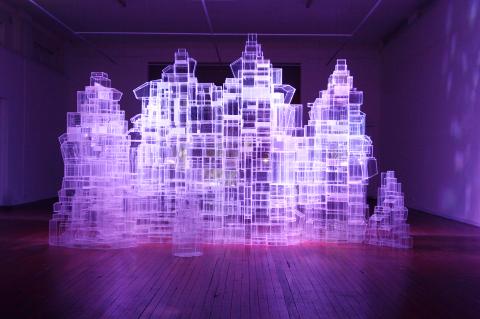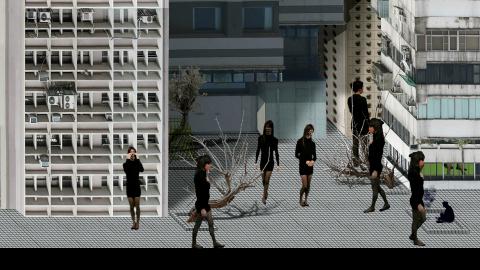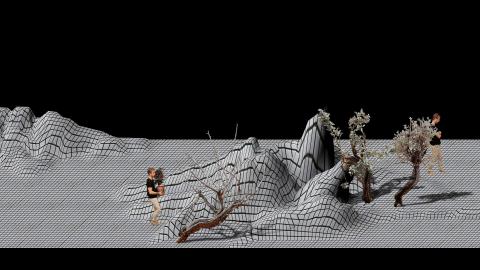Peter Nelson’s video Extensions of a No-Place (Wen Zhengming) contains traces of T. S. Eliot’s epic 1921 poem, The Waste Land: It is a barren and black-and-white landscape, where the most redeeming features are the dry stone of mountains, dotted with dead trees, juxtaposed with broken fragments of poetry and song.
It is disarming in such a way that you want to get inside this bleak, futuristic landscape (recalling the movie Tron Legacy in many ways) and stand beside the isolated characters.
But in this sense his exhibition, Extensions of a No-Place, which is part of the National Palace Museum’s New Waves Show in Tainan — comprising video, drawings and sculpture — achieves an aim of Chinese painting: to make the viewer want to swap places with the figures therein.

Photo courtesy of Peter Nelson
While it shares with The Waste Land alienation and fragmentation, high-intellectualism and broad allusion, Nelson takes artistic inspiration from Song Dynasty landscape paintings, such as Wen Zhengming’s (文徵明) Imitating Zhao Bosu’s Illustration of the Latter Red Cliff (仿趙伯驌后赤壁圖) and Qiu Ying’s (仇英) Spring Morning in the Han Palace (漢宮春曉).
Fractures
Nelson, who is Australian, is searching for something: perhaps the redemption that is a core part of The Waste Land; perhaps self-identity. Australia has arguably turned away from its mainly European roots to become part of the Asian continent it inhabits, rendering it the unintentional cultural heir of East and West.

Photo courtesy of Peter Nelson
Nelson’s search has taken him through Chinese landscapes, the 18th century British picturesque (Thomas Gainsborough and George Stubbs) and the 1970s utopian visions of the future. Physically, it has taken him to Paris, Chongqing, Beijing and Taipei, where he is doing a six-month residency at Treasure Hill Artists Village.
Wherever he goes, he is an outsider, alienated by language, culture and location, condemned to never really forming the bonds of community that allow for sustainable growth. This fracturing is reflected in the subject of his art, and also in the assorted media he uses, and within them the juxtaposition of cultural references and samples, forming a collage of recycled motifs. They combine to depict a pluralistic modern world of East and West.
Extensions of a No-Place (Wen Zhengming) takes the soft curves and colors of the mountains in Wen’s Imitating Zhao Bosu’s Illustration of the Latter Red Cliff, and replaces them with monotone mountains draped in patterns reminiscent of Taipei’s ubiquitous street tiles. The grid this creates, and which can be projected across five screens, brings it into line with the utopian architectural motif of squares. Taking landscape as coded self-portraiture further, Nelson places himself within it, appropriately, as the “lost man.”

Photo courtesy of Peter Nelson
Video games and chinese painting
Human instinct is to exert control — over ourselves, over others — in the quest for order, perfection or happiness. That we will create entire worlds to achieve this is exploited by the realms of fantasy and video games.
In Nelson’s second video, Extensions of a No-Place (Qiu Ying’s Spring Morning in the Han Palace), he draws parallels between the video game Starcraft and the Han Court, despite the 500-year-gap, through their use of isometric angles and oblique parallel perspective, which ensures the scenes have no vanishing points and objects are the same size no matter whether they appear in the foreground or background.
The effect, referred to as “moving perspective” in Chinese painting, is an endlessly extendable scene where no single point on the landscape has hierarchy over another (which is good for both ambulatory Chinese scrolls and large-scale sci-fi battles), and in terms of time, past and present are conflated, making the concept of time irrelevant.
In Nelson’s Qiu Ying the court buildings are replaced with a Sonyshop and Taipei apartments, and the female courtesans with versions of Nelson in drag, while the soundtrack plays in Mandarin and English lyrics from US rapper Eminem’s Without Me.
Mountains
It all started in the soaring, sublime mountains of China’s Zhangjiajie National Park, Hunan Province. The title of Mountain Drawing (The First Time I felt at Home), a 2.6m by 4.2m perspex sculpture, indicates that Nelson felt a connection.
But could this also be where it ends? In Qiu Ying, there is a devilish figure crouched down, creating smoke. This is in fact a silhouette of Nelson destroying First Time.
Shorn of The Waste Land’s spirituality, or any other redeeming feature, perhaps the title’s No-Place can only rely on Nelson’s Jade-like mountain sculptures — his final medium made from celadon ceramic through a 3D printer — to bear the burden of beauty and hope, where Jade represents purity, nobility and perfection.
Still, Nelson says he destroyed the sculpture in order to recycle it, which again recalls The Waste Land’s cycle of birth and death. In the poem’s very last stanza, many read hope in the Fisher King’s final words: “These fragments I have shored against my ruins.” Perhaps Nelson’s message is, with these fragments, that we can build our worlds.

We lay transfixed under our blankets as the silhouettes of manta rays temporarily eclipsed the moon above us, and flickers of shadow at our feet revealed smaller fish darting in and out of the shelter of the sunken ship. Unwilling to close our eyes against this magnificent spectacle, we continued to watch, oohing and aahing, until the darkness and the exhaustion of the day’s events finally caught up with us and we fell into a deep slumber. Falling asleep under 1.5 million gallons of seawater in relative comfort was undoubtedly the highlight of the weekend, but the rest of the tour

Youngdoung Tenzin is living history of modern Tibet. The Chinese government on Dec. 22 last year sanctioned him along with 19 other Canadians who were associated with the Canada Tibet Committee and the Uighur Rights Advocacy Project. A former political chair of the Canadian Tibetan Association of Ontario and community outreach manager for the Canada Tibet Committee, he is now a lecturer and researcher in Environmental Chemistry at the University of Toronto. “I was born into a nomadic Tibetan family in Tibet,” he says. “I came to India in 1999, when I was 11. I even met [His Holiness] the 14th the Dalai

Following the rollercoaster ride of 2025, next year is already shaping up to be dramatic. The ongoing constitutional crises and the nine-in-one local elections are already dominating the landscape. The constitutional crises are the ones to lose sleep over. Though much business is still being conducted, crucial items such as next year’s budget, civil servant pensions and the proposed eight-year NT$1.25 trillion (approx US$40 billion) special defense budget are still being contested. There are, however, two glimmers of hope. One is that the legally contested move by five of the eight grand justices on the Constitutional Court’s ad hoc move

Stepping off the busy through-road at Yongan Market Station, lights flashing, horns honking, I turn down a small side street and into the warm embrace of my favorite hole-in-the-wall gem, the Hoi An Banh Mi shop (越南會安麵包), red flags and yellow lanterns waving outside. “Little sister, we were wondering where you’ve been, we haven’t seen you in ages!” the owners call out with a smile. It’s been seven days. The restaurant is run by Huang Jin-chuan (黃錦泉), who is married to a local, and her little sister Eva, who helps out on weekends, having also moved to New Taipei